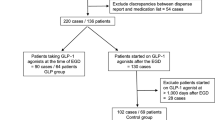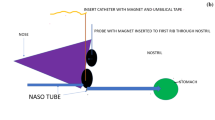Abstract
Introduction
Gastroparesis, which can be viewed as a syndrome featuring nausea, vomiting, and abdominal pain, and associated other symptoms and findings, is increasingly seen by surgeons. Gastroparesis is associated with a number of gastrointestinal anatomic and physiologic findings.
Materials and Methods
This article reviews the use of bioelectric therapy of neuromodulation, via gastric electrical stimulation, for patients with drug refractory gastroparesis syndromes including surgical aspects of device placement and subsequent management.
Results and Discussion
In addition to an overall approach to the placement and subsequent management of gastric electrical stimulation devices, several newer concepts are discussed. The role of pyloric dysfunction in gastroparesis is also discussed including how stimulation devices and pyloric therapies may be used in concert. The additions of full-thickness gastrointestinal biopsies along with other physiologic, including GI electrophysiology, as well as some serologic measures, are also discussed. In addition, evolving approaches and emerging technologies for bioelectric neuromodulation of the gastrointestinal tract are introduced.
Conclusions
Gastroparesis syndromes can be approached in a systematic manner based on known pathophysiology and when indicated can be helped with surgical therapies including neuromodulation.











Similar content being viewed by others
References
Camilleri M, Parkman HP, Shafi MA, et al. Clinical guideline: management of gastroparesis. Am J Gastroenterol 2013;108:18-37.
Liu N, Abell T. Gastroparesis updates on pathogenesis and management. Gut Liver 2017;11:579-589.
Pasricha PJ, Colvin R, Yates K, et al. Characteristics of patients with chronic unexplained nausea and vomiting and normal gastric emptying. Clin Gastroenterol Hepatol 2011;9:567-76.e1-4.
Malagelada JR, Camilleri M. Unexplained vomiting: a diagnostic challenge. Ann Intern Med 1984;101:211-8.
Hibbard ML, Dunst CM, Swanstrom LL. Laparoscopic and endoscopic pyloroplasty for gastroparesis results in sustained symptom improvement. J Gastrointest Surg 2011;15:1513-9.
Khashab MA, Ngamruengphong S, Carr-Locke D, et al. Gastric per-oral endoscopic myotomy for refractory gastroparesis: results from the first multicenter study on endoscopic pyloromyotomy (with video). Gastrointest Endosc 2017;85:123-128.
Malik Z, Sankineni A, Parkman HP. Assessing pyloric sphincter pathophysiology using EndoFLIP in patients with gastroparesis. Neurogastroenterol Motil 2015;27:524-31.
Abell TL, Kedar A, Stocker A, et al. Gastroparesis syndromes: response to electrical stimulation. Neurogastroenterol Motil 2019;31:e13534.
Rey E, Choung RS, Schleck CD, et al. Prevalence of hidden gastroparesis in the community: the gastroparesis “iceberg”. Journal of neurogastroenterology and motility 2012;18:34-42.
Jung HK, Choung RS, Locke GR, 3rd, et al. The incidence, prevalence, and outcomes of patients with gastroparesis in Olmsted County, Minnesota, from 1996 to 2006. Gastroenterology 2009;136:1225-33.
Wang YR, Fisher RS, Parkman HP. Gastroparesis-related hospitalizations in the United States: trends, characteristics, and outcomes, 1995-2004. Am J Gastroenterol 2008;103:313-22.
Grover M, Farrugia G, Lurken MS, et al. Cellular changes in diabetic and idiopathic gastroparesis. Gastroenterology 2011;140:1575-85 e8.
Grover M, Farrugia G, Lurken MS, et al. Cellular changes in diabetic and idiopathic gastroparesis. Gastroenterology 2011;140:1575-85.e8.
Payne SC, Furness JB, Stebbing MJ. Bioelectric neuromodulation for gastrointestinal disorders: effectiveness and mechanisms. Nat Rev Gastroenterol Hepatol 2019;16:89-105.
Abell TL, Yamada G, McCallum RW, et al. Effectiveness of gastric electrical stimulation in gastroparesis: Results from a large prospectively collected database of national gastroparesis registries. Neurogastroenterol Motil 2019;31:e13714.
Abell TL, Chen J, Emmanuel A, et al. Neurostimulation of the Gastrointestinal Tract: Review of Recent Developments. Neuromodulation 2015;18:221-227.
Burlen J, Runnels M, Mehta M, et al. Efficacy of gastric electrical stimulation for gastroparesis: US/European Comparison Gastroenterology Research 2018;11:349-354.
Elmasry M, Hassan H, Atassi H, et al. Baseline predictive factors for fore and hind gut response to long-term GI electrical stimulation (Abstract, In Press). 2019.
Shine A, Abell TL. Role of gastric electrical stimulation in the treatment of gastroparesis. Gastrointestinal Disorders 2020;2:12-26.
O'Grady GO, Abell TL. Low- and High-Resolution Mapping of Gastric Electrical Activity. Gastroenterology Clinics of North America 2015;44:169-184.
O'Grady G, Egbuji JU, Du P, et al. High-frequency gastric electrical stimulation for the treatment of gastroparesis: a meta-analysis. World J Surg 2009;33:1693-701.
Singh S, McCrary J, Kedar A, et al. Temporary endoscopic stimulation in gastroparesis-like syndrome. J Neurogastroenterol Motil 2015;21:520-7.
Burlen J, Runnels M, Mehta M, et al. Efficacy of gastric electrical stimulation for gastroparesis: US/European comparison. Gastroenterology Res 2018; 11:349-354.
Atassi H, Abell TL. Gastric electrical stimulator for treatment of gastroparesis. Gastrointest Endosc Clin N Am 2019;29:71-83.
Grover M, Bernard CE, Pasricha PJ, et al. Diabetic and idiopathic gastroparesis is associated with loss of CD206-positive macrophages in the gastric antrum. Neurogastroenterology and motility: the official journal of the European Gastrointestinal Motility Society 2017;29:https://doi.org/10.1111/nmo.13018.
Wendorf G, Lahr C, Tang SJ, et al. Importance of endoscopy during permanent gastric stimulator placement. Video GIE [In Press] 2020.
Harrison NS, Williams PA, Walker MR, et al. Evaluation and treatment of gastric stimulator failure in patients with gastroparesis. Surg Innov 2014;21:244-9.
Zoll B, Jehangir A, Edwards MA, et al. Surgical treatment for refractory gastroparesis: stimulator, pyloric surgery, or both? J Gastrointest Surg 2019.
Davis BR, Sarosiek I, Bashashati M, et al. The long-term efficacy and safety of pyloroplasty combined with gastric electrical stimulation therapy in gastroparesis. J Gastrointest Surg 2017;21:222-227.
Arthur LE, Slattery L, Richardson W. Tailored approach to gastroparesis significantly improves symptoms. Surg Endosc 2018;32:977-982.
Ashat M, Lewis A, Liaquat H, et al. Intravenous immunoglobulin in drug and device refractory patients with the symptoms of gastroparesis—an open-label study. Neurogastroenterology & Motility 2018;30:e13256.
Lahr CJ, Griffith J, Subramony C, et al. Gastric electrical stimulation for abdominal pain in patients with symptoms of gastroparesis. Am Surg 2013;79:457-64.
Omer E, Kedar A, Nagarajarao HS, et al. Cajal cell counts are important predictors of outcomes in drug refractory gastroparesis patients with neurostimulation. J Clin Gastroenterol 2019;53:366-372.
Deb S, Tang SJ, Abell TL, et al. An endoscopic wireless gastrostimulator (with video). Gastrointest Endosc 2012;75:411-5, 415.e1.
Deb S, Tang SJ, Abell TL, et al. Development of innovative techniques for the endoscopic implantation and securing of a novel, wireless, miniature gastrostimulator (with videos). Gastrointest Endosc 2012;76:179-84.
Acknowledgments
The authors would like to thank the colleagues and staff at the Medical University of South Carolina, the University of Mississippi, and the University of Louisville, as well as Catherine McBride for help with manuscript preparation. The figures include slides from Dr. Charu Subramony at the University of Mississippi, whose help is appreciated.
Author information
Authors and Affiliations
Contributions
William Lancaster: concept; drafting, manuscript revisions, final approval
Abigail Stocker: concept; drafting, manuscript revisions, final approval
Thomas Abell: concept; drafting, manuscript revisions, final approval
David Adams: concept; drafting, manuscript revisions, final approval
Corresponding author
Ethics declarations
Conflict of Interest
Dr. Abell is a former licensor, investigator, and consultant for Medtronic and is the founder of ADEPT-GI, which holds IP on some aspects of temporary GI stimulation as well as on autonomic and enteric profiling for GI related disorders. The remaining authors declare that they have no conflict of interest.
Additional information
Publisher’s Note
Springer Nature remains neutral with regard to jurisdictional claims in published maps and institutional affiliations.
Rights and permissions
About this article
Cite this article
Adams, D., Stocker, A., Lancaster, W. et al. The Surgeon’s Role in Gastric Electrical Stimulation Therapy for Gastroparesis. J Gastrointest Surg 25, 1053–1064 (2021). https://doi.org/10.1007/s11605-020-04850-w
Received:
Accepted:
Published:
Issue Date:
DOI: https://doi.org/10.1007/s11605-020-04850-w




